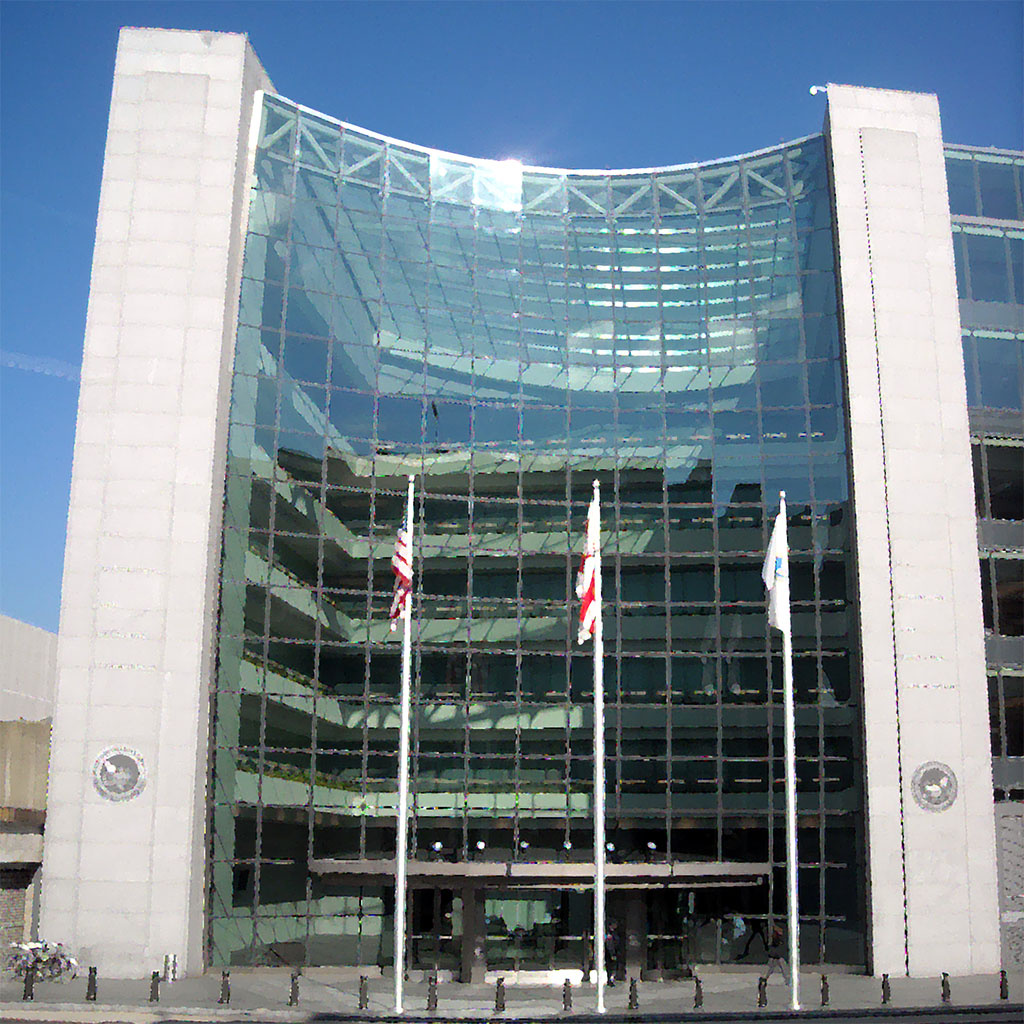Any time commentators like me invoke the term Satanism, we run the risk of being dismissed out of hand by people whose image of Satanism was formed in the 1980s. As a child of that decade, I remember the “Satanic panics” among Christian groups that specifically targeted the music industry. For instance, the name of the rock band, KISS, was imagined to stand for Knights In Satan’s Service, some insisted ACDC stood for Anti-Christ, Devil’s Child; and the name of my personal favorite band, Rush, was imagined to stand for Ruled Under Satan’s Hand. In the 80s, the concept of “backward masking” also emerged: The idea was that if you played a vinyl record of a Satan-influenced band backward, sometimes you could hear voices speaking messages about the devil. Led Zeppelin’s blockbuster album IV became a target of this imaginative frenzy of accusation, and it was further said of that album that the inlay painting of a man on a hill, when held to a mirror, formed the picture of a fearsome devil dog.
If that sounds outlandish, it certainly was. Those of us who lived through those waves of cultural-religious panic were relieved when people came to their senses and stopped destroying records. One outcome of that frenzy of religious accusation still seen today is that Satan and Satanism have become a comedic punchline associated with naive irrationality. One of my childhood heroes, the late Rush drummer Neil Peart, addressed the controversy following an accusatory news article from a Christian activist group. Peart said:
As one who knows many of these “demonic figures” personally, especially some of those mentioned in the article, the idea of some of these sold-out, burnt-out, cynical, strutting peacocks being so deeply and religiously committed to anything (save their “image” and chart numbers) is also a bit of a joke. And a pretty lame one at that! … Yes, you Christian crypto-fascists, it is a joke! The only problem is—you’re not laughing.
Rush fans like me enjoyed reading Peart’s witty condemnation of these excesses from Christian groups. And later, we laughed at the shrieking Church Lady on Saturday Night Live, whose puritanical “SATAN!!!” outbursts humorously cemented the symbolic end of the Satanic panics that had emerged in the 1980s.
Those panics in the 1980s may be reminiscent of another panic that took place decades earlier but then among political conservatives. In the red scare of the 1950s, Senator Joe McCarthy’s public hounding of Americans in the name of anti-communism captured the country’s attention and has lingered in American consciousness as an example of how fanaticism can leave a trail of innocent lives wrecked in its wake.
For Latter-day Saints, in particular, anti-communism has left a significant mark on our psyche. Notably, apostle Ezra Taft Benson has been portrayed by many to be a purveyor of extreme anti-communist ideology during his service in the Quorum of the Twelve. And Cleon Skousen’s anti-communist tracts are influencing political commentary into the present. Adding to people’s sense of alarm, they and others have contributed to the view that communism and socialism are Satanic ideologies.
Wary of panics and hysteria, many of us have come to view these kinds of references to Satanism and communism with disdain, automatically and laughingly dismissing any suggestions of the same. Arguably as a direct consequence of these historical and cultural memories, many in America no longer believe that either Satan or communism are threatening realities. I have not second-guessed these instincts myself until only recently.
Going deeper. Has there been a Satanic influence in popular music? Or was Neil Peart correct in his assessment that rock musicians were too self-absorbed to pay attention to abstractions like Satanism? The answer to that question depends on how we define Satanism. Common notions of Satanism envision worship of Satan, occult rituals, pentagrams, and even a statue of Baphomet shown in public to counter the presence of the ten commandments.
But a more accurate description of what Satanism really involves is found in the words of Blanche Barton, “Magistra Templi Rex” of the Church of Satan:
The idea of worshiping Satan is ridiculous. We worship ourselves first and foremost, and we use the Satanic as a metaphor for calling forth the powers within ourselves that we find enriching or enlivening. Satan has always been a metaphor of defiance, fortitude against all odds, and self-determination in whatever guises he is represented.
Returning to questions of Satanic influence in rock music, and continuing Led Zeppelin as an example, it’s interesting to note that guitarist Jimmy Page became enamored with the ideas of Aleister Crowley, an occultist who claimed to receive from a supernatural being a set of teachings called The Book of The Law. This formed the foundation for Thelema, Crowley’s belief system named after the Greek word for “self.” These teachings have been foundational to modern Satanism, to the point where many refer to him as the godfather of the movement.
The image here is of evil transforming the soul into something like a vat of acid, consumed with the compulsion to criticize, tear down, and deconstruct.
In an article on Crowley and modern Satanism, Asbjorn Dyrendal explains that “[Crowley’s] discourse makes use of and contributes to a literary tradition of positive discourse on Satan, and it is central to the disembedding of Satan from Christian demonology and re-embedding him into an esoteric discourse as something positive.”
Self-worship as the highest aspiration. And what is that something positive? It is self-worship, the insistence that one’s desires ought to never be “repressed” by culture, religion, or any other influence—and, indeed, in which any sort of suppression of the same becomes the “greatest … sin.” Or, as Marilyn Manson famously described the core of Satanism, it was about “being your own god.”
This brings us back to the hero of my youth, Neil Peart. It seems he was correct and that Christian critics were wrong to paint Rush and other bands as true Satan worshippers. But have Christian groups been correct in warning about Satanic influence in popular music? If we rightly identify the heart of Satanism as unfettered worship of self and will, then the answer is yes: just as it is true that many other areas of art, literature, and entertainment reflect that same influence.
For example, in Glennon Doyle’s blockbuster book Untamed, she writes that …
We were taught to believe that who we are in our natural state is bad and dangerous. They convinced us to be afraid of ourselves. So we do not honor our own bodies, curiosity, hunger, judgment, experience, or ambition. Instead, we lock away our true selves … I love myself now. Self-love means that I have a relationship with myself built on trust and loyalty. I trust myself to have my own back, so my allegiance is to the voice within. I’ll abandon everyone else’s expectations of me before I’ll abandon myself. I’ll disappoint everyone else before I’ll disappoint myself. I’ll forsake all others before I’ll forsake myself.
Doyle has achieved great success as a writer advocating for self as the supreme authority over every aspect of daily life. And her invocation of religion extends this mindset—God, in this view, is only ever to be conceptualized as affirming of our every impulse and desire.
For another example, observe how modern epicurean writers are obsessed with only the central panel of Heironymous Bosch’s three-panel painting, “The Garden of Earthly Delights,” while ignoring the left and right panels. The three panel work moves from the innocence of the Garden of Eden, to the hedonistic debaucheries of our fallen world, to the punishments of hell. Their focus on the central panel and complete ignoring of the other two suggests that they worship a god very much of this world, one that denies anyone can ever really become innocent or pure, and who whispers there will never be any reckoning for our deeds here on earth.
Or, as Aleister Crowley’s supernatural entity states in the Book of the Law, “Be strong, o man! lust, enjoy all things of sense and rapture: fear not that any God shall deny thee for this.”
Seen through this lens, Satanism as self-worship seems very banal. But the more unsettling implications of Satanic influence in popular music persist, and not without reason. The Netflix documentary ReMastered: Devil at the Crossroads explores the life of guitarist Robert Johnson and the rumors that his skills were obtained through a pact with Satan. Johnson was part of what is called “the 27 club,” a surprisingly large group of popular musicians who died at the age of 27 after meteoric rises to fame. When asked if Led Zeppelin’s success was obtained through evil influences, Jimmy Page has always been evasive. In more recent examples, rappers Lil Nas X and Lil Uzy Vert both make explicit references to Lucifer in their current work. And the controversial TikTok star Flyysoulja posted a video narrative of a conversation with a demon, leading to a flurry of commentary suggesting that this is a regular occurrence in the music industry.
Satan, self-worship, and Marx. Back to communism now. Having earlier mentioned Joseph McCarthy’s red scare and prominent Latter-day Saints’ warnings about the Satanic nature of communism, is there any substance to those claims as well? Or is this another example of Satanic panic applied to politics? Again, the answer depends upon how we define important terms—in this case, communism. And if our definition of communism is the forced collectivization of society or some other narrow concept, we will be led to examine a straw man. I would argue communism is better defined as the application of Marxist assumptions and worldview to the economic ordering of society.
It’s hard to do justice to the breadth and all-encompassing nature of Marx’s theories here, but at a basic level, Marx operated from the following assumptions:
- Society can be divided into two basic classes (bourgeois and proletariat).
- The proletariat, lower class are victims of a social structure of oppression that keeps them alienated, which is conceptualized mainly as being disconnected from the product of one’s labor.
- The oppressive structure of society is maintained by a superstructure of religion and culture, which blinds and anesthetizes people to their own oppression.
In what sense is any of this Marxist teaching rightly considered by some to be “Satanic?” Enter Catholic writer Paul Kengor and his recent book The Devil and Karl Marx. Kengor’s book has been correctly criticized for its often ranting tone, but it nevertheless contains important insights into Marx’s inner world. Drawing heavily on Robert Payne’s well-respected 1968 biography of Marx, Kengor points out Marx’s fixation on the theme of self-supremacy in his writings; his use of the Satanic narrative of defiance of God; and his personal loathing for any system, religious or otherwise, that would inhibit the expression of his self-liberation.
Perhaps most telling is Marx’s focus on criticism as the primary means for achieving his vision of society. As he wrote:
The criticism of religion is the prerequisite of all criticism. … Religion is the sigh of the oppressed creature, the heart of a heartless world, and the soul of soulless conditions. It is the opium of the people. … The abolition of religion as the illusory happiness of the people is the demand for their real happiness. To call on them to give up their illusions about their condition is to call on them to give up a condition that requires illusions. The criticism of religion is, therefore, in embryo, the criticism of that vale of tears of which religion is the halo.
In reading this statement from Marx, we might be tempted to agree to some extent. Religion does, in fact, benefit from some forms of critical analysis to correct its errors and temper its excesses. But Marx has something more extreme in mind. As he clarifies:
Criticism is no passion of the head, it is the head of passion. It is not a lancet, it is a weapon. Its object is its enemy, which it wants not to refute but to exterminate. For the spirit of that state of affairs is refuted. In itself, it is no object worthy of thought, it is an existence which is as despicable as it is despised. Criticism does not need to make things clear to itself as regards this object, for it has already settled accounts with it. It no longer assumes the quality of an end-in-itself, but only of a means. Its essential pathos is indignation, its essential work is denunciation.
I’ve written previously on denunciation as a tool in revolutionary tyranny, and particularly its implications for Latter-day Saint understanding of Satan. The impulse to denounce is essentially destructive, especially when there is no constructive vision offered by the critic. In his book People of the Lie, M. Scott Peck explores the nature of evil, including a psychiatrist’s first-hand perspective on demonic possession. Some of his insights seem particularly relevant:
The spirit I witnessed at each exorcism was clearly, utterly, and totally dedicated to opposing human life and growth. It told both patients to kill themselves. When asked in one exorcism why it was the Antichrist, it answered, “Because Christ taught people to love each other.”… Queried more, it simply said to the exorcist, “I want to kill you.” There was absolutely nothing creative or constructive about it; it was purely destructive (my emphasis again added).
The image here is of evil transforming the soul into something like a vat of acid, consumed with the compulsion to criticize, tear down, and deconstruct. And the primary targets of these compulsions are good people and things, influences in the world that create and edify and heal.
Satanic influences ultimately create conflict-ridden, accusatory, oppositional communities that are only capable of thriving on criticism, chaos, and constant attempts to incite more revolution.
This is, of course, a caricature of the left: that socialists and communists spend more time in meetings and fighting with each other than changing the world. But in the wake of Donald Trump’s presidential election, and then Joe Biden’s, it has become nearly all-consuming for some organizations, spreading beyond subcultures of the left and into major liberal institutions. “My last nine months, I was spending 90 to 95 percent of my time on internal strife. Whereas [before] that would have been 25-30 percent tops,” the former executive director said. He added that the same portion of his deputies’ time was similarly spent on internal reckonings.
The social systems and critical processes Marx envisioned are, of course, inseparable from the personal experiences of his own life, and in the words of biographer Robert Payne, “There were times when Marx seemed to be possessed by demons, when rage overflowed in him and became poison, and he seemed to enter into a nightmare.” Whatever else others might say in praise of his life’s work, the direct fruits of his personal attitudes are not hard to discern: an unwillingness to work to support his own family; a loathing for life and the world around him; suicide fantasies that came to fruition in the lives of two of his children; delusions of power; constant conflict with everyone around him; and utter failure to ever transcend his personal impulses.
Marxism in real life. If Marx’s personal demons are horrifying, seeing them become the delusionary basis for state policy has been worse. As Kengor argues:
No other political ideology has produced as much wretched poverty, rank repression, and sheer violence. In country after country, implemented in varying forms across wide-ranging nationalities, traditions, backgrounds, faiths, and ethnicities, communism coldly and consistently violated the full sweep of most basic human rights, from property to press, from speech to assembly, from conscience to religion. So restrictive was communism in the twentieth century that its implementers routinely refused to allow citizens the right to exit (that is, escape) the destructive systems imposed within their borders. In some cases, they erected walls to herd and fence in the “masses” they claimed to champion.
He states again, “That bears repeating: so restrictive was communism that its advocates had to build walls—poured with cement, topped with barbed wire, patrolled 24/7 by secret police with automatic weapons turned on their own citizenry—to keep their people from fleeing.”
The horrors of Communism are sometimes dismissed as erroneous past implementations of Marx’s ideas: the objection always seems to be that these systems based in Marxist assumptions about reality always failed because they weren’t Marxist enough! But beyond the question of political and economic systems, the question of Marx’s demons and his ideology has become particularly relevant in recent years, with the rise of critical theory in all of its various forms throughout the West. In his podcast, The New Discourses, James Lindsay has done lengthy readings of Marxist thought, ranging from Marx to his various branches of influence in critical theory down to the present.
Lindsay shows that even critical-theorist critiques of Marx have been backhanded compliments, accepting-while-modifying his basic model of oppressive society that is reinforced by a superstructure of ideology. In the present, our “oppression superstructures” have expanded to include white supremacy, heteronormativity, meritocracy, patriarchy, and even “healthism,” creating systems of oppression toward the “marginalized” who then need to awaken their critical consciousness in order to throw off oppressive influences of religion, tradition, family, and culture.
Marxism in the world. At the time of the writing of Payne’s 1968 biography of Marx, he noted that half the world was under the rule of governments that based their systems on Marxist thinking. This brings to mind a passage in restoration scripture that expands upon Jesus’ parable of the wheat and tares: “That great church, the mother of abominations, that made all nations drink of the wine of the wrath of her fornication, that persecuteth the saints of God, that shed their blood—she who sitteth upon many waters, and upon the islands of the sea—behold, she is the tares of the earth … .”

With that in mind, it is important to understand, as James Lindsay has argued, that Marxism is happy to replace Judeo-Christian understanding of God with a new theology, including a new God. In the words of Marx that mirror Crowley and his acolytes in modern Satanism, the ideal is for man to “move around himself as his own true Sun. Religion is only the illusory Sun which revolves around man as long as he does not revolve around himself.” Theologically speaking, just as Christ was eager to point our worship to the Father, Satan is eager to point our worship to our ego, the thing Westerners call “self.” In questions of what is or is not “Satanic,” we can do no better than to start there.
Which returns us to the question of whether popular music and communism are Satanic. Are they? A good answer is that sometimes they can be. A collectivist society is no more inherently Satanic than a capitalist one, and popular music is no more inherently Satanic than any other form of music. Yet let us not stop our thinking there. Because with a little more digging, at least this much becomes clear: The question of Satanic influence in economic systems, art, entertainment, or anything else for that matter, may well be answered in the extent to which these things lead to worship of the self.

















